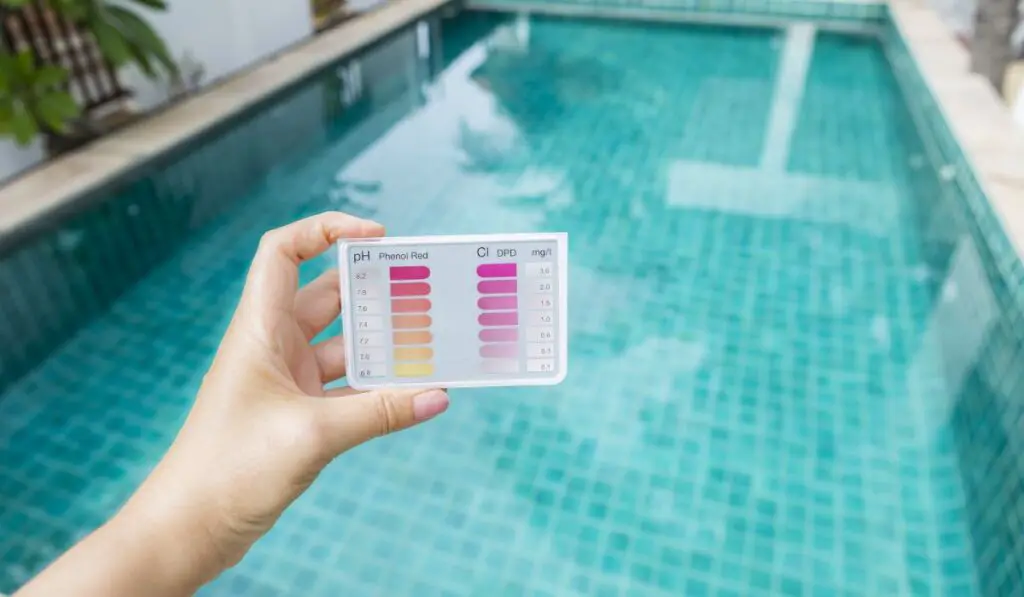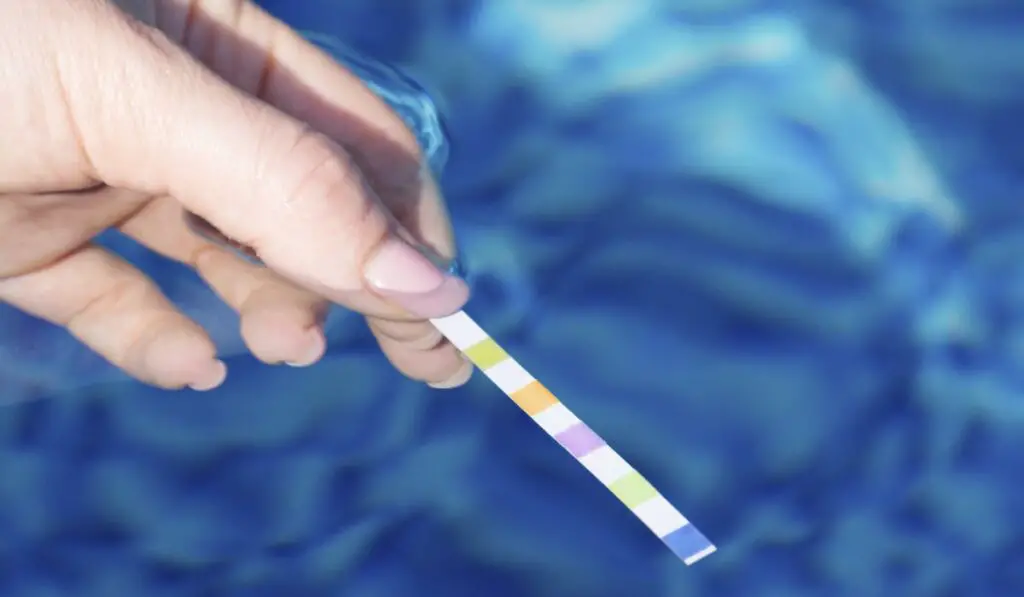A swimming pool is excellent for relaxing or hanging out with friends and family. Unfortunately, problems may arise with your pool’s water, and one of the most common issues is a low pH level. So, why is your pool’s pH low?
Your pool’s pH could be low due to rainwater from heavy storms or low-pH water being added to your pool. Body oils, sweat, and other acidic waste brought into the pool by swimmers may also affect your pool’s pH. Check your reagents, add soda ash, or aerate the water to fix this low pH.
Understanding why your pool’s pH is low is essential to properly fix the issue and keep your pool in the best condition. Let’s get into the details and look at the signs of low pH in a pool and how to raise it so you can get back to enjoying your pool.
What Causes a Pool to Have a Low pH?

Your pool may have a low pH due to the following reasons:
- Rainwater from heavy storms
- Low-pH water added in the pool, such as well water or city water
- Sweat, body oils, and other acidic waste brought in by swimmers
- Excess pool sanitizers like bromine or chlorine
- Low total alkalinity
- Dichlor shock
What Are the Signs of Low pH in a Pool?
A pH lower than 7.0 indicates that your pool is too acidic. When the pH drops to this level, it’s very noticeable due to the following signs:
- Irritation of the eyes and mucous membranes- As your pool’s pH drifts farther away from the 7.4 to 7.6 range, the more intense the irritation to the eyes and mucous membranes will be.
- Corrosion- If your pool’s pH level is too low, the acidic levels can cause corrosive damage to various parts of your pool.
- Cloudy water- When the pH is too low, it can make the water appear cloudy, as the chlorine in the pool is less effective in killing bacteria and other contaminants.
- Algae growth– Pool water with a pH below 7.2 is considered acidic. Algae thrive in this acidic water because the low pH causes the water to contain more nutrients, which the algae use to bloom and grow.
- Scale buildup- A low pH can make pool water acidic, leading to calcium and other minerals in the pool becoming more soluble and, thus, forming scale on pool walls and other surfaces. A low pH also messes with the chemical balance in a pool, causing increased bacteria growth and contributing to scale buildup.
How Do You Raise a Pool’s pH?
Here are a couple of steps you can take to raise your pool’s pH level and get it back in balance:
Check Your Reagents
Before conducting extra tests and adding more products to your pool, ensure your reagents are up to date. Replace your test strips annually and if these are expired, purchase a new testing kit and test again.
Add Soda Ash
Soda ash is a highly alkaline substance that easily dissolves in water and leaves behind minimal residue. Adding it to your pool water will raise its pH level and reduce acidity. However, take care when adding soda ash to avoid a high pH level, as it can lead to different problems.
To use it correctly:
- Calculate how much soda ash you’ll need depending on the size of your pool. Stay under two pounds per 10000 gallons of water.
- Ensure the pump is working well and can circulate the water.
- Distribute the soda ash evenly across the entire surface of the water.
- Let the pool circulate water for at least an hour before testing again.
Check the Total Alkalinity and Make the Necessary Adjustments
Total alkalinity is the number of basic substances present in the water. Random changes in the pool’s pH levels may occur if the total alkalinity levels are too low. You should check your total alkalinity if you’ve added the recommended amount of soda ash and still have a low pH level.
Sodium bicarbonate (baking soda) is comparable to soda ash and can be used to increase the total alkalinity of a swimming pool.
Add 1.4 pounds of Sodium bicarbonate per 10,000 gallons of water and wait for the pool to circulate before testing again. If you need help calculating the exact amount, use my total alkalinity calculator.
Aerate the Water
If adding alkalines doesn’t raise your pool’s pH levels, aerating it can be an effective solution. This process can take a long time, sometimes even days, but it’s effective. To aerate the water, direct the jets to the surface, or add aeration pipes above the jets.
How to Test the pH Levels in Your Pool
You can test your pool’s pH levels with the following:
Testing Strips

Strip testing is an easy, fast, and cost-effective way to test your pool’s pH levels. All you have to do is dip the pH strip tester(on Amazon) into the pool’s water and then compare the color to a chart.
Though using pH testing strips can be a quick and convenient way to check your pool’s acidity levels, the cost of purchasing multiple packs of strips can pile up over time. Each pack of strips typically contains between 50 to 100 strips and can cost up to $20. It may seem small, but the cost can add up quickly if you use them frequently.
Electronic Testers
Electronic testers(on Amazon) are another effective way of testing your swimming pool’s pH. They have several advantages compared to test strips.
First, they are more accurate than test strips. You can get an inaccurate reading with test strips if you don’t use them correctly. On the other hand, electronic pH testers will provide you with an accurate reading every time.
Electronic testers are also much quicker than test strips. Test strips can take several minutes to get a reading, while electronic testers can give you a reading in a matter of seconds with just a few button presses.
Additionally, investing in an electronic pH tester is a cost-effective solution in the long run. Even though these testers can be more expensive, costing up to $100, you won’t have to keep buying refills, as it’s a one-time purchase.
DIY Testing
If you can’t get your hands on a testing strip or an electronic tester, you can use science and a unique vegetable to test your pool’s pH. You’ll need red cabbage and distilled water for this strange method.
Boil the distilled water and throw in the whole red cabbage. Let the cabbage boil for at least 30 minutes while you stir it from time to time. Strain the water after 30 minutes to remove any solid particles. The water should be purplish. Put pool water into a plastic container and add a few drops of the purple liquid.
Your pool’s water pH will determine its color. A light red shows acidity, a purple shade points to neutrality, and a light green signifies alkalinity. To obtain a numerical measurement, use a pH test chart to compare the color. This approach is tedious, but it’ll give you the correct results.
How Often Should You Check Your Pool’s pH Levels?
You should check your pool’s pH levels as frequently as your chlorine balance: 2-3 times a week. Keeping your pH levels in check will ensure your chlorine is highly effective and that your pool stays fresh, clean, and safe for swimming!
